 |
||
|
||
| ||
Read also: In the RAID0 mode each controller can take 1-4 discs. The tests were conducted for each configuration. The discs were connected this way:
The links below will help you jump to the part you are interested in. 1 discHere we are testing operation in the 'additional IDE controller' mode. At the same time you can estimate the characteristics of the Fujitsu discs. Ziff-Davis WinBench 99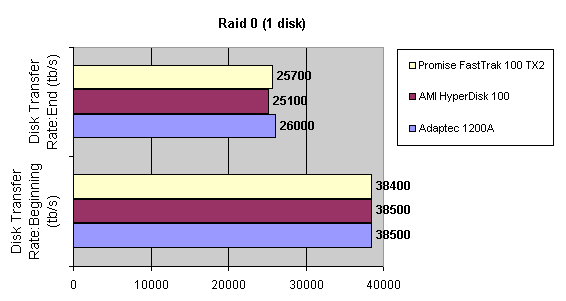 The linear reading speed doesn't depend on the controller. The graphs are standard, that is why I don't display them. The Adaptec has the smoothest ones. 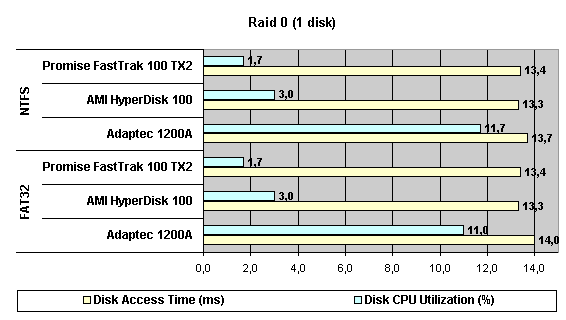 But the Adaptec falls considerably behind in access time and CPU utilization. 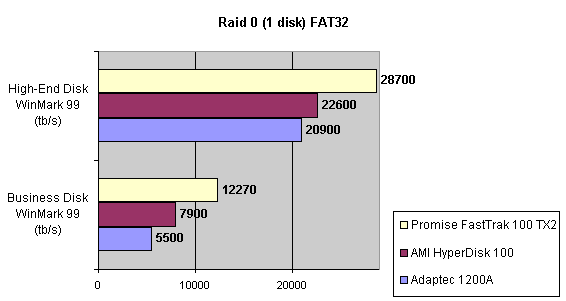 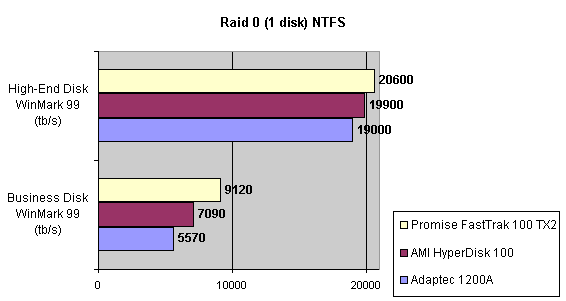 In the Disk WinMarks tests the Promise is an absolute leader, while the Adaptec comes the last again. Intel IOMeterServer Pattern 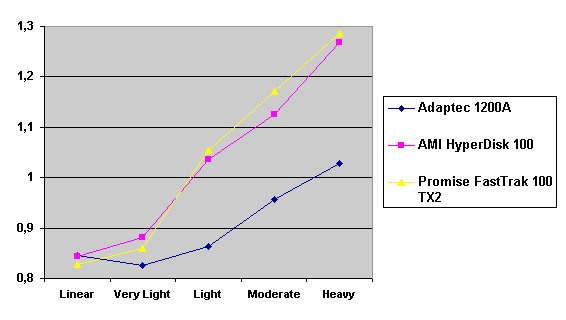 Workstation Pattern 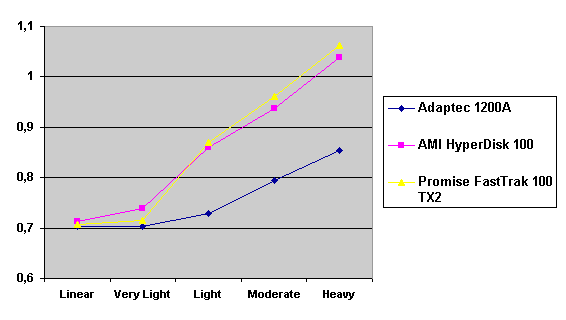 Database Pattern 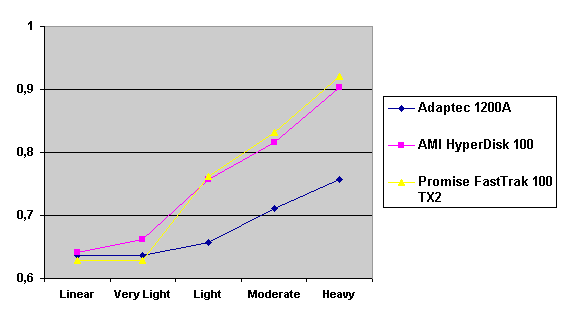 Here is an explanation of such a poor operation of the Adaptec in the Ziff-Davis WinMarks. The controller can't stand high load. Streaming Read 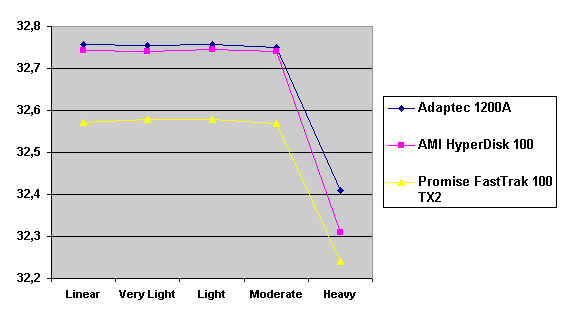 Streaming Write 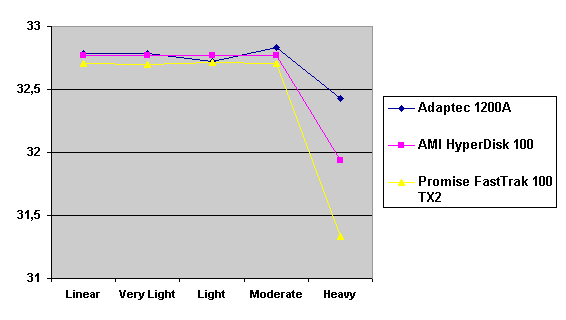 In the streaming patterns the Promise takes the last place; and the results become worse as the load increases – the controller doesn't have enough time for processing of 256 read/write requests simultaneously with one connected disc. Random Read 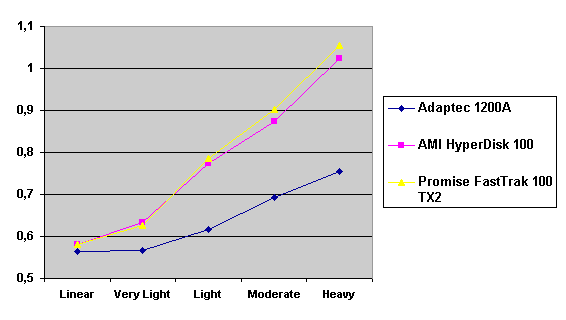 Random Write 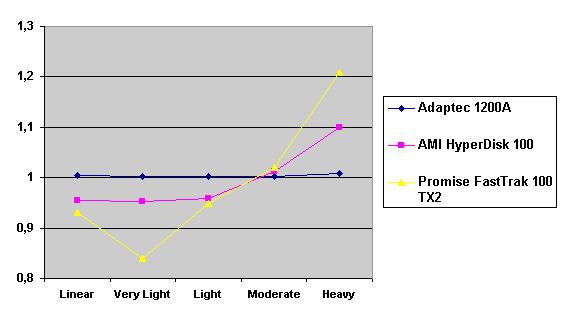 I think that the fall in the Promise graph
is obviously an error. 2 discs2 discs is an optimal configuration for a dual-channel controller. Ziff-Davis WinBench Adaptec 1200A  AMI HyperDisk100  Promise FastTrak 100 TX2 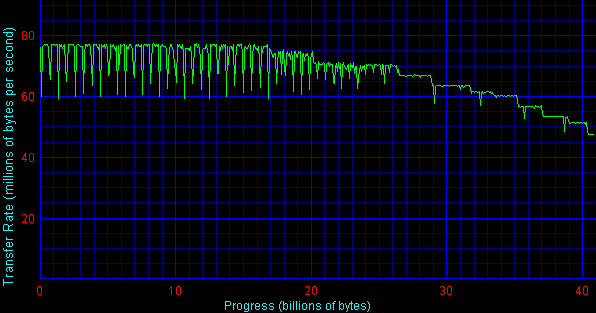 While the Promise works in a classic style (reading and writing operations are implemented successively from the beginning of the discs) the Adaptec and AMI distribute the units on the discs so that the data exchange rate will be constant. The AMI seems to be more successful in it. But because of the saw-like graph the AMI's minimal reading speed at the beginning is almost the same as of the Adaptec. The Promise controller has also a saw on its graph. 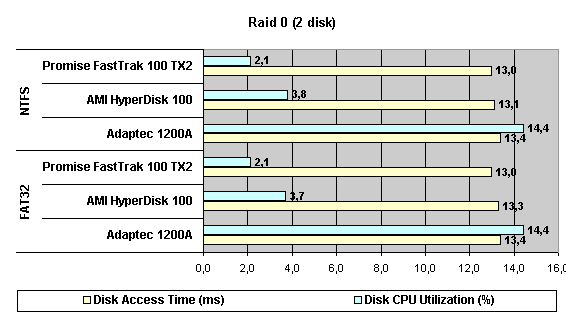 Now the controllers have more or less equal access times, but in the CPU utilization the Adaptec still lags behind. 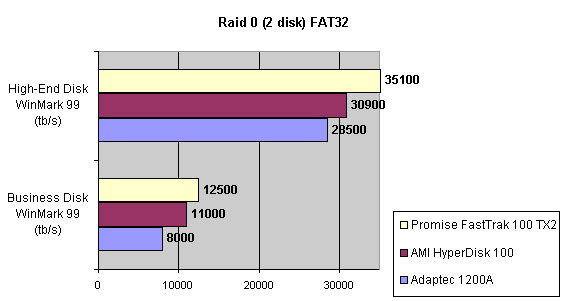 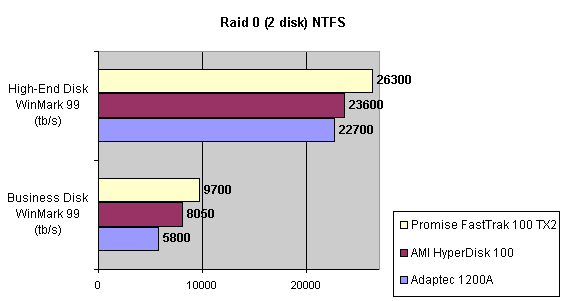 In the Disk WinMarks the results are a little higher. Intel IOMeterServer Pattern 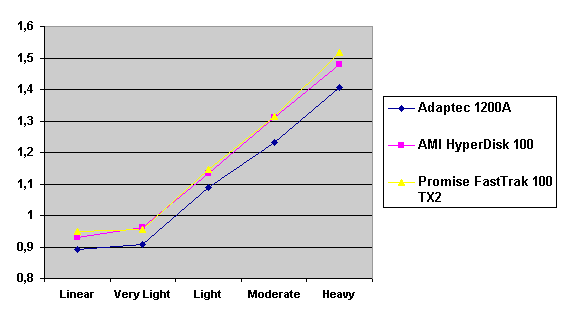 Workstation Pattern 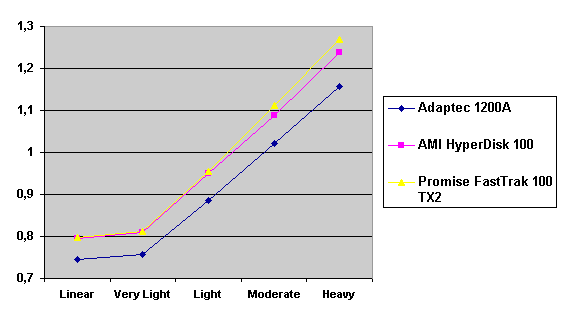 Database Pattern 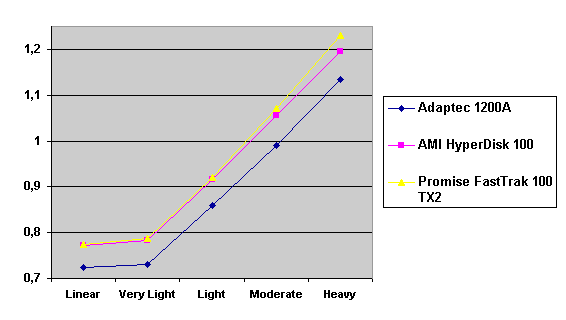 The graphs are almost equal. The Adaptec has worse results but there are no more such falls as with one disc. Streaming Read  Streaming Write 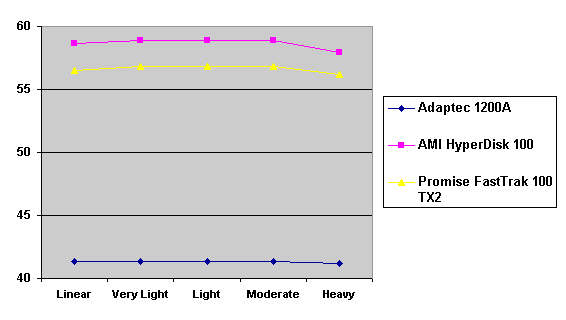 In the streaming mode the AMI HyperDisk100 takes the first place. The Adaptec is far behind. Random Read 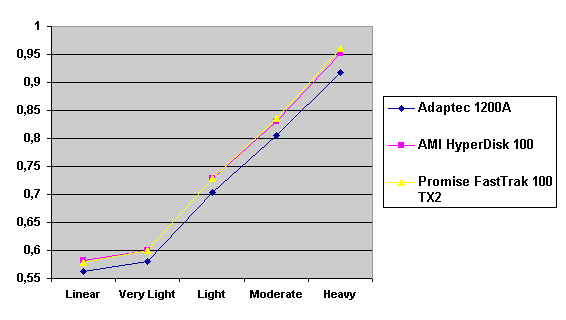 Random Write 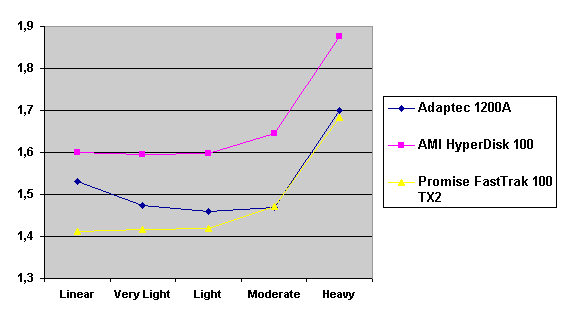 In the random mode the Adaptec beats the Promise.
But the difference is not significant. 3 discsA bit unbalanced configuration - two discs are on one controller and one is on the other. Ziff-Davis WinBench Adaptec 1200A 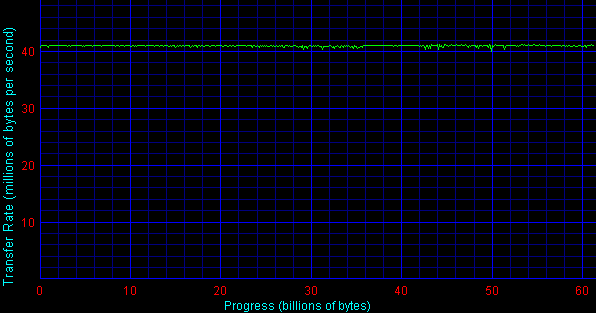 AMI HyperDisk100 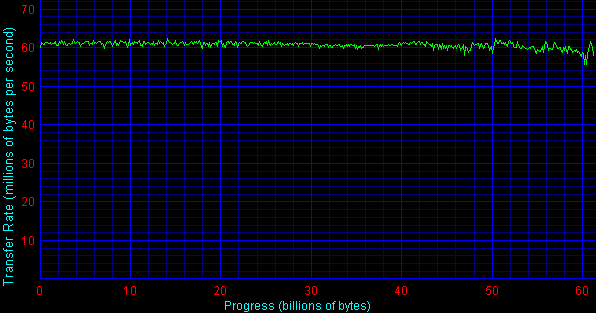 Promise FastTrak 100 TX2 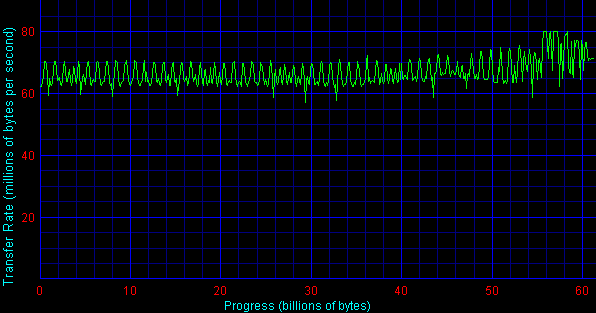 The linear reading graph of the Promise reminds me one of the AMI for two-disc configuration! In the three-disc configuration the Promise places array units according to a different algorithm. The graphs of the AMI and of the Adaptec became evener, though the reading speed of the latter dropped as compared with the two-disc configuration. 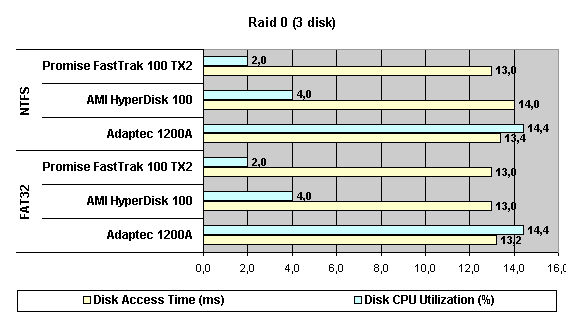 As far as access time is concerned, it is the AMI controller that doesn't shine here (in the NTFS). The CPU utilization is just the same. 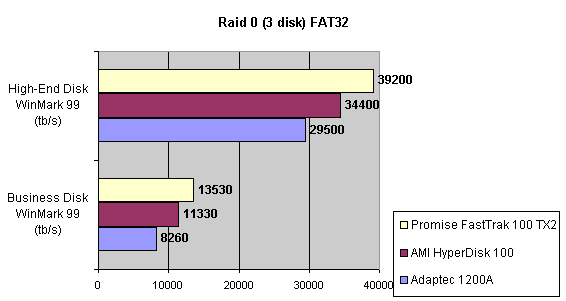 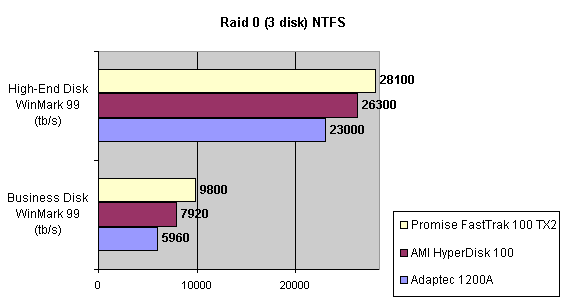 In the Disk WinMarks the allocation is the same. Even the Adaptec's results have increased. Intel IOMeterServer Pattern 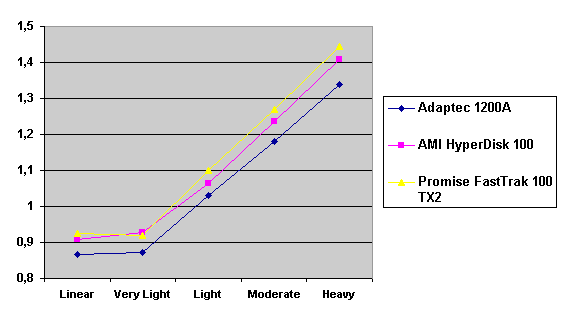 Workstation Pattern  Database Pattern 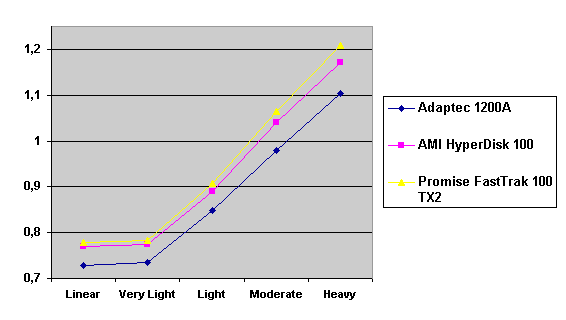 The results have dropped.... Streaming Read 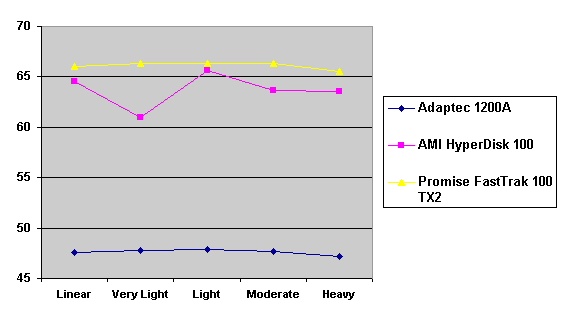 Streaming Write 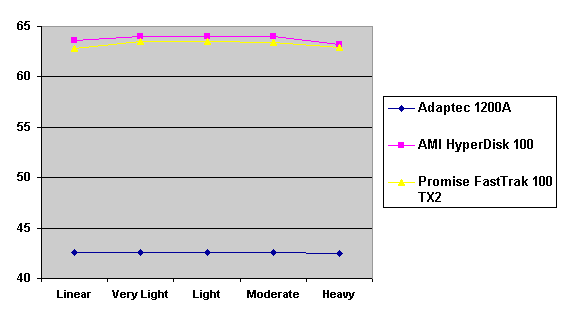 Here we can see a bit lower reading results (except the hard-to-explain fall of the AMI) and some growth in recording operations. Random Read 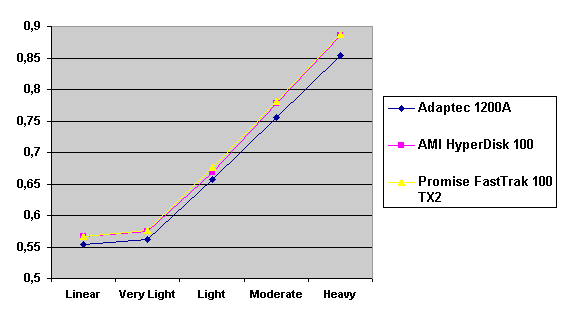 Random Write 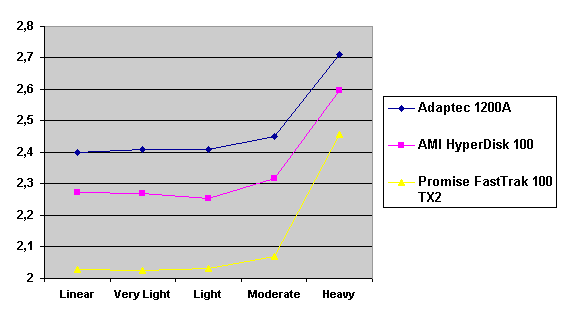 The Adaptec becomes unexpectedly a leader in the
Random Write test. It seems that its record caching algorithms suit
better asymmetric configurations. 4 discsZiff-Davis WinBench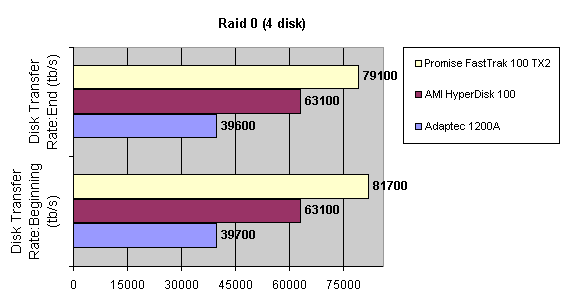 Adaptec 1200A  AMI HyperDisk100 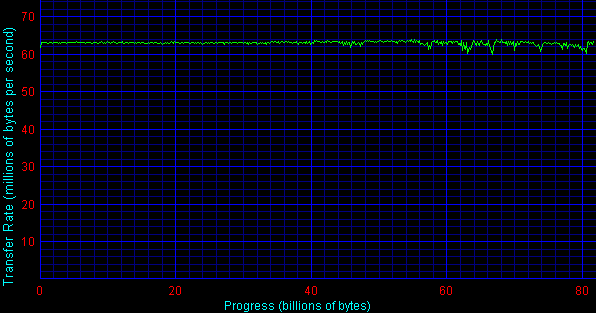 Promise FastTrak 100 TX2 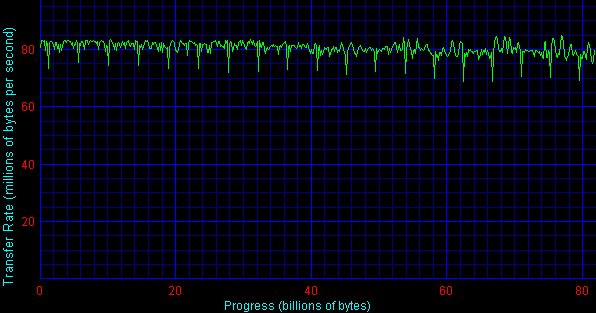 Now all controllers provide a stable reading speed. The best graph belongs to the Adaptec (but it has the lowest speed), the worst one belongs to the Promise (but it is the fastest :)). 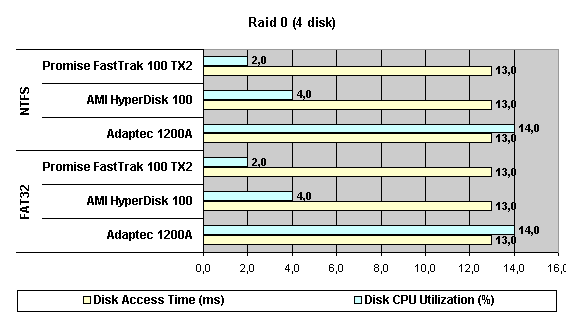 The access time is equally minimal for all controllers. 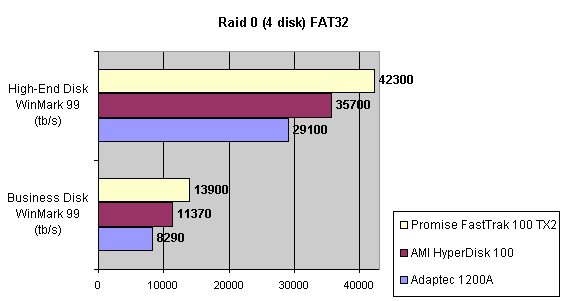 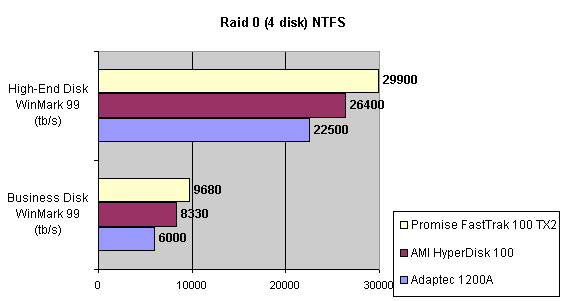 In the Disk WinMarks test nothing has changed. The Adaptec doesn't still like to have more than 2 discs. Intel IOMeterServer Pattern 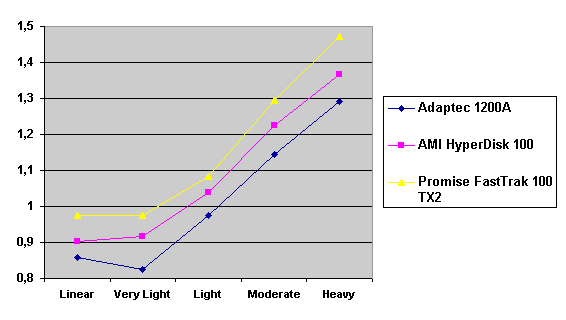 Workstation Pattern 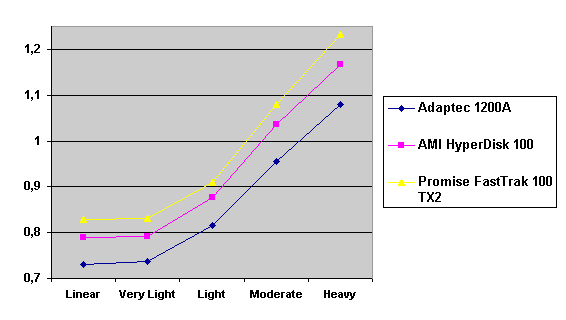 Database Pattern 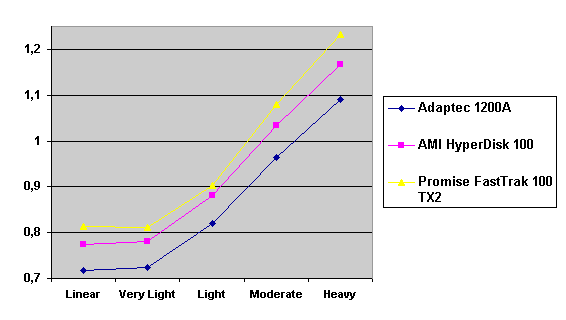 The Promise's results have grown a bit as compared with others. Streaming Read 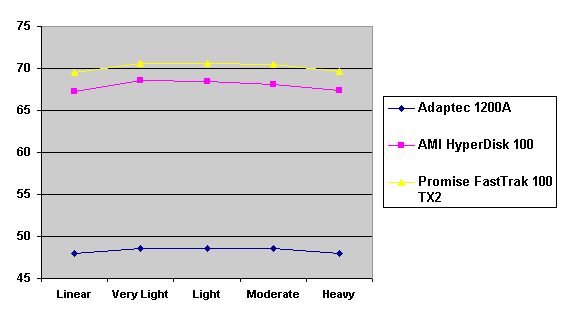 Streaming Write 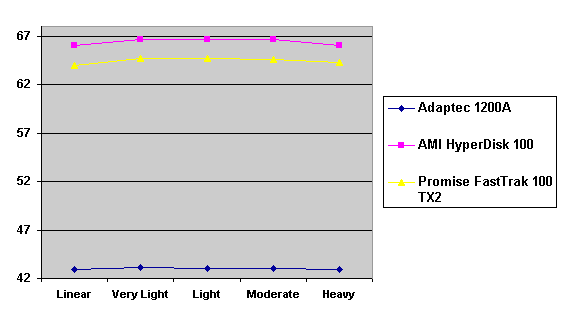 Here we have a little overall growth. Random Read 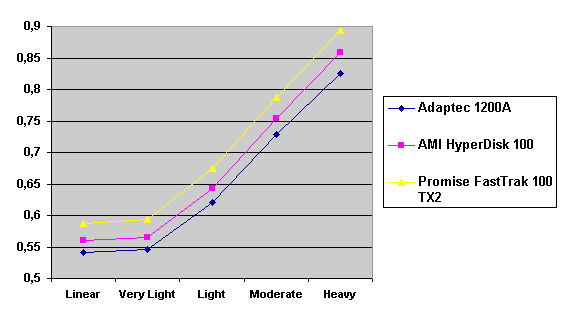 Random Write 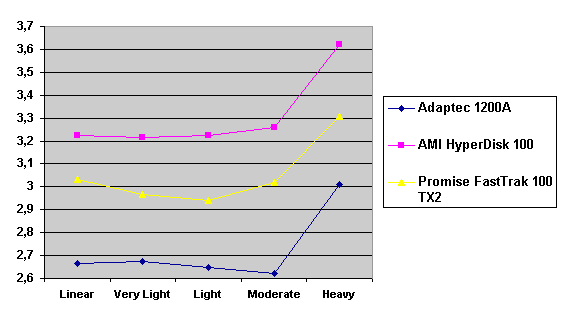 The Promise and the AMI surely have problems
with an asymmetric configuration. At last, we turn to the the bandwidth dependency on the number of discs (Intel IOMeter). The results are given for the Light (16 outstanding I/Os) and the Heavy (256 outstanding I/Os) loads. 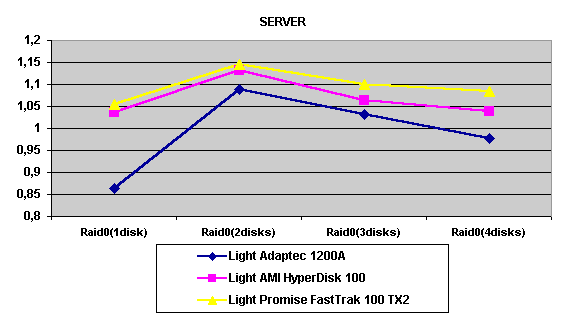 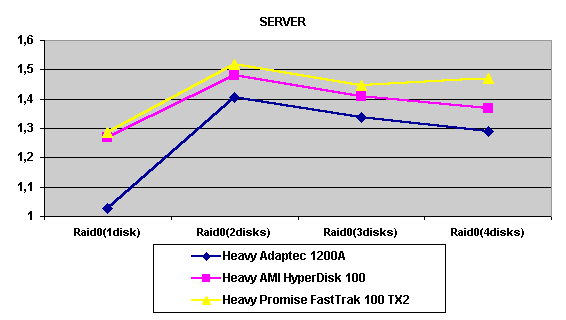 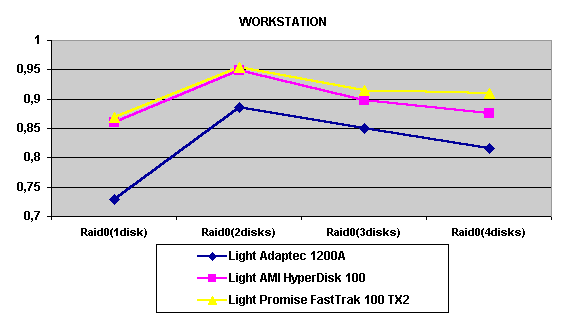 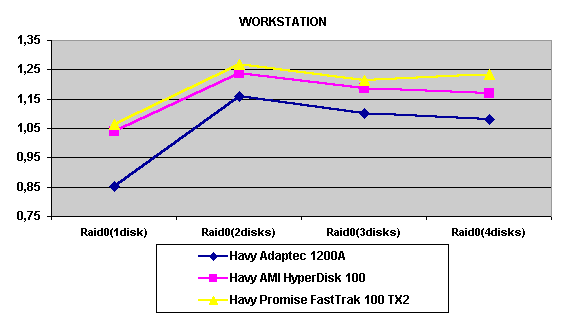 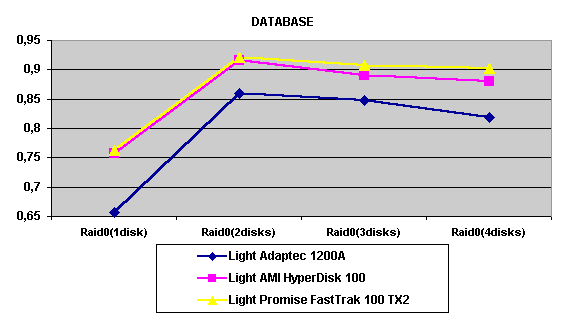 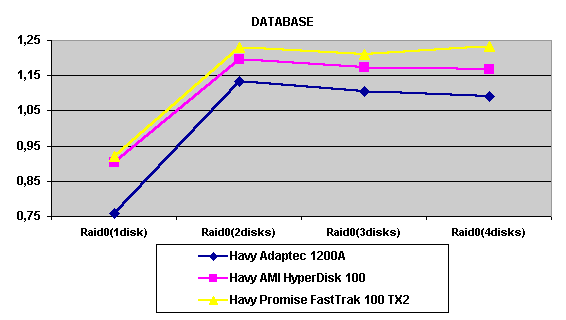 The maximum is reached in a two-disc configuration in almost all cases. The results become lower for the 3-disc one and for the rest, except the Promise whose results become better afterwards.  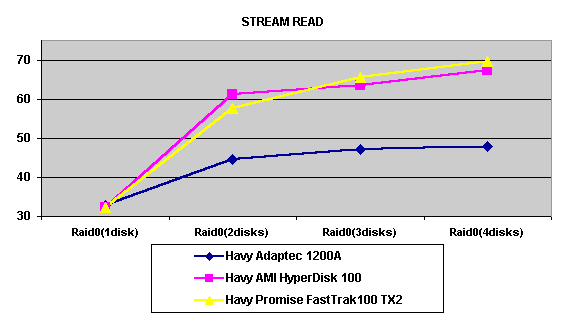 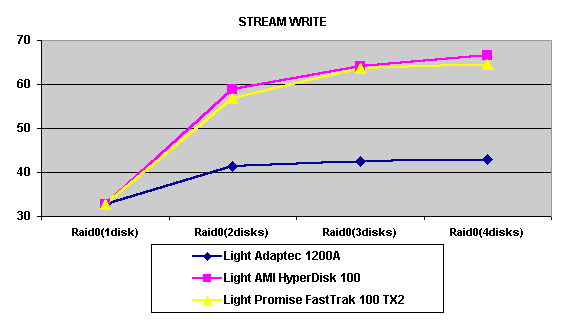 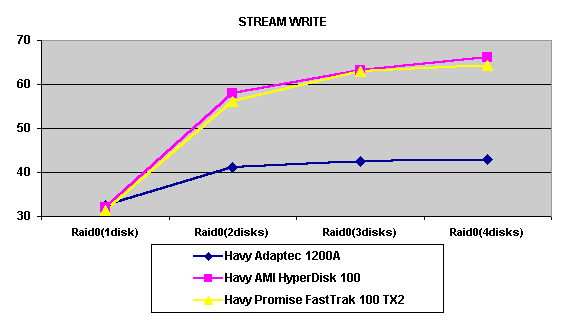 Here we can see again a small growth as the number of discs increases. The AMI and the Promise go on a par.  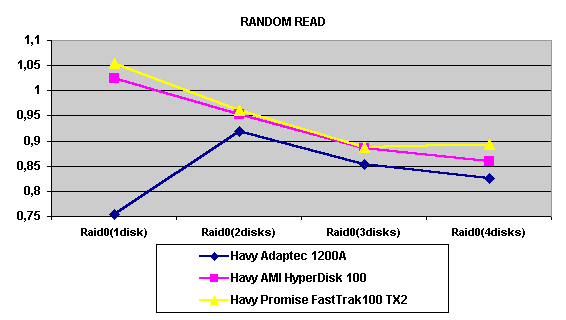 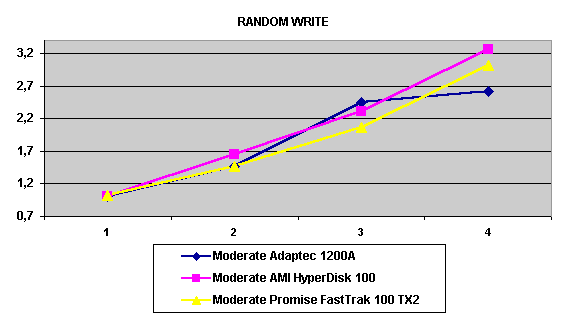 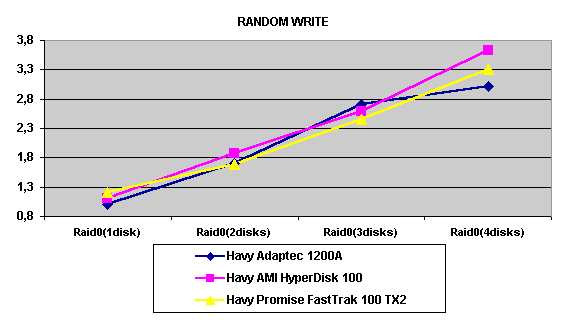 In random operations the results are again falling
down as the quantity of discs increases: the array size is now higher...
In recording operations the disc size is balanced by caching, that
is why the results grow and do not differ much. ConclusionThe Promise FastTrak100 TX2 is undoubtedly a leader. The AMI HyperDisk100 is very close to it, and the Adaptec 1200A comes the last. It has excellent linear reading graphs, but a too low speed... As far as the number of discs is concerned, a two-disc configuration is optimal from a price/speed standpoint. The complete results can be found in the tables.Ziff-Davis
WinBench 99
Read also:Introduction
and summary
Write a comment below. No registration needed!
|
Platform · Video · Multimedia · Mobile · Other || About us & Privacy policy · Twitter · Facebook Copyright © Byrds Research & Publishing, Ltd., 1997–2011. All rights reserved. |